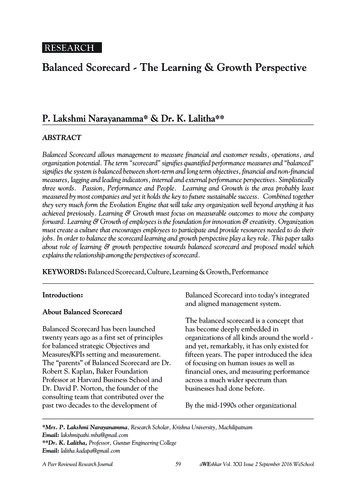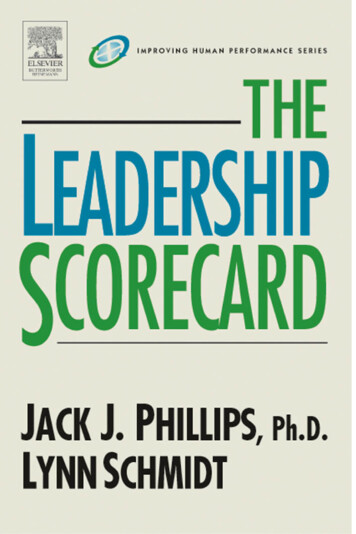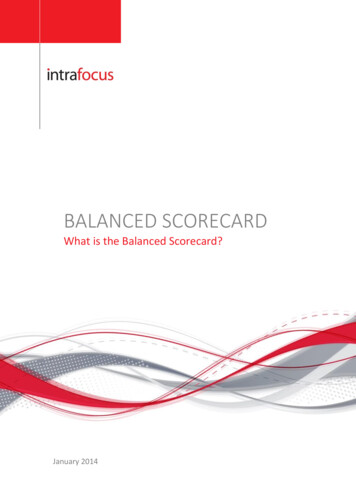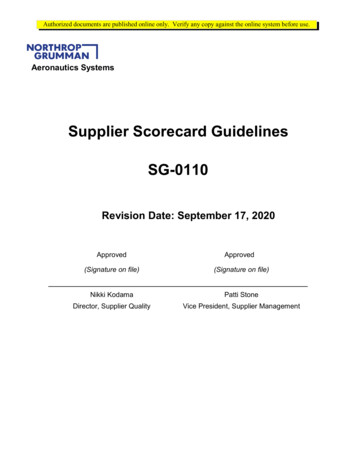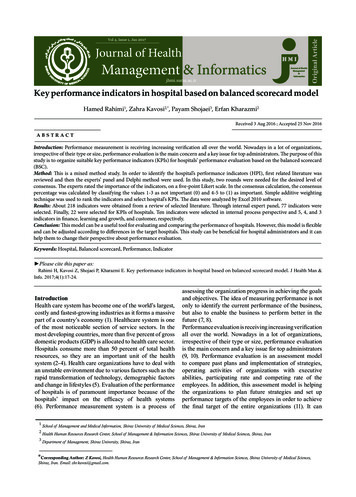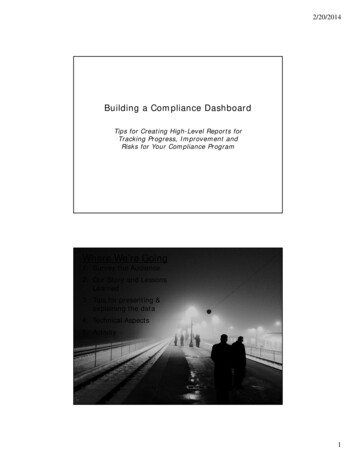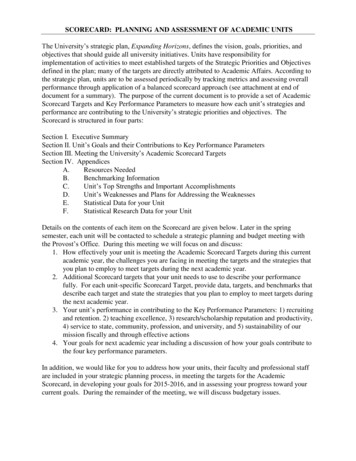
Transcription
SCORECARD: PLANNING AND ASSESSMENT OF ACADEMIC UNITSThe University’s strategic plan, Expanding Horizons, defines the vision, goals, priorities, andobjectives that should guide all university initiatives. Units have responsibility forimplementation of activities to meet established targets of the Strategic Priorities and Objectivesdefined in the plan; many of the targets are directly attributed to Academic Affairs. According tothe strategic plan, units are to be assessed periodically by tracking metrics and assessing overallperformance through application of a balanced scorecard approach (see attachment at end ofdocument for a summary). The purpose of the current document is to provide a set of AcademicScorecard Targets and Key Performance Parameters to measure how each unit’s strategies andperformance are contributing to the University’s strategic priorities and objectives. TheScorecard is structured in four parts:Section I. Executive SummarySection II. Unit’s Goals and their Contributions to Key Performance ParametersSection III. Meeting the University’s Academic Scorecard TargetsSection IV. AppendicesA.Resources NeededB.Benchmarking InformationC.Unit’s Top Strengths and Important AccomplishmentsD.Unit’s Weaknesses and Plans for Addressing the WeaknessesE.Statistical Data for your UnitF.Statistical Research Data for your UnitDetails on the contents of each item on the Scorecard are given below. Later in the springsemester, each unit will be contacted to schedule a strategic planning and budget meeting withthe Provost’s Office. During this meeting we will focus on and discuss:1. How effectively your unit is meeting the Academic Scorecard Targets during this currentacademic year, the challenges you are facing in meeting the targets and the strategies thatyou plan to employ to meet targets during the next academic year.2. Additional Scorecard targets that your unit needs to use to describe your performancefully. For each unit-specific Scorecard Target, provide data, targets, and benchmarks thatdescribe each target and state the strategies that you plan to employ to meet targets duringthe next academic year.3. Your unit’s performance in contributing to the Key Performance Parameters: 1) recruitingand retention. 2) teaching excellence, 3) research/scholarship reputation and productivity,4) service to state, community, profession, and university, and 5) sustainability of ourmission fiscally and through effective actions4. Your goals for next academic year including a discussion of how your goals contribute tothe four key performance parameters.In addition, we would like for you to address how your units, their faculty and professional staffare included in your strategic planning process, in meeting the targets for the AcademicScorecard, in developing your goals for 2015-2016, and in assessing your progress toward yourcurrent goals. During the remainder of the meeting, we will discuss budgetary issues.
Balanced Scorecard Instructions for Academic UnitsPage 2 of 5Balanced Scorecard GuidanceSection I: Executive Summary:1) Briefly describe how your unit contributes to meeting the Academic Scorecard targets.2) Briefly describe how your unit contributes to the Key Performance Parameters.Section II. Unit Goals and Contributions to the University’s Key Performance Parameters:The University’s Strategic Plan contains five Strategic Priorities: Recruit and retain an outstanding and diverse student body of broad interests and ofsufficient size to ensure a rewarding campus life experience.Recruit, develop, and retain an outstanding and diverse faculty and staffBroaden and expand the research portfolioBe a recognized leader in selected areas of education and research: Aerospace andSystems Engineering; Biotechnology; Cybersecurity and Big Data; Earth, Atmospheric,and Space Science; and Gaming and Entertainment ArtsEngage more fully our stakeholders: alumni, the community, elected officials, and globalpartnersTo help achieve these priorities, the Office of Academic Affairs has defined five KeyPerformance Parameters. These parameters describe a set of essential responsibilities that eachunit is accountable for performing, consistent with the university’s strategic priorities:1.2.3.4.5.Recruiting and retention of faculty and studentsTeaching excellenceResearch/scholarship reputation and productivityService to state, community, profession, and universitySustainability of our mission fiscally and through effective actionsThe purpose of this subsection is for each unit to state the unit's goals and to link each goal to oneor more of the Key Performance Parameters. Each unit must show that all of the KeyPerformance Parameters are incorporated in their goals.Mission and Goals1. Describe the extent to which goals identified in prior years’ reports were met. Includeinformation on methods used for evaluation and ways in which the results have been usedfor improvement.2. State your unit’s primary goals (three to five only) for the upcoming academic year(2015-16) and provide the following information for each goal, either by writing a shortparagraph or bullets:a. How the goal contributes to the Key Performance Parameters.b. Progress if it is a goal continuing from previous yearsc. Plans for the upcoming year3. State your unit's primary five-year goals (three to five only).
Balanced Scorecard Instructions for Academic UnitsPage 3 of 5a. Describe your five-year plans for each five-year goal, either by writing a shortparagraph or bullets for each goal.Section III. Meeting the University’s Academic Scorecard Targets:Academic Scorecard Targets are metrics that relate specifically to the Objectives defined withinthe University’s Strategic Plan. The purpose of this section is for each unit to show itscontribution to each of the Academic Scorecard targets in terms of:1. strategies used to address each of the Academic Scorecard measures andtargets, and providing an assessment of their effectiveness,2. discuss progress made toward meeting Academic Scorecard targets this year,2014-2015, and3. define strategies planned to meet Academic Scorecard targets in 2015-2016For units where some of the Academic Scorecard measures do not apply, those units are asked todevelop three to five Academic Scorecard targets that measure the unit's academic performance.The unit's Scorecard should include important student-based parameters such as:1. enrollment2. student quality (entering class academic profile)3. critical retention rate4. graduation rateThe nine elements of the Academic Scorecard are given below. Appendices “E” and “F” providethe current status of each metric. Units should discuss its contribution to each of the following:1. Undergraduate and Graduate Enrollment by College2. Academic profile of entering class (ACT Score, HS GPA)3. Degrees Awarded by Major for bachelor’s, master’s and Ph.D. degrees4. Year 1 to Year 2 and Year 2 to Year 3 Retention Rates5. Six-year Graduation Rate (also show 4-year graduation rate)6. Research Output (Peer Reviewed Publications, Refereed Conference Papers, ResearchAwards and Expenditures, Creative Achievements per Faculty)7. Faculty Workload (Faculty/Student Ratio, Average course load, Credit Hours Generated)8. Utilization of Underrepresented Faculty and Women9. External programs, events, and activitiesSection IV. AppendicesAppendix A. Resources NeededDiscuss any additional resources your unit needs to meet the Academic Scorecard Targetsand to contribute effectively to the Key Performance Parameters. Examples of resourcesneeded include personnel, fiscal, space/facilities, information technology. Indicate if theresource is existing or additional. Identify potential sources for the resources needed andprovide a brief strategy of how the resource will be used to achieve the stated goal.
Balanced Scorecard Instructions for Academic UnitsPage 4 of 5Goal No.:Type of ResourceExistingAdditional:state sourceStrategyAppendix B. Benchmarking InformationIdentify the public universities in the United States that have the top 10 colleges in yourdiscipline(s) and at least five colleges at other United States public universities which areconsidered to be your peers.Appendix C. Unit's Top Strengths and Important AccomplishmentsDescribe your unit's top strengths and important accomplishments achieved in the last five years.Appendix D. Unit's Weaknesses and Plans for Addressing the WeaknessesDescribe your unit's weaknesses, including any involving the Scorecard metrics, and your plansfor addressing those weaknesses. Include in your discussion any institutional assistance that yourunit requires in addressing those needs.Appendix E. Unit Statistical ProfileThe Office of Institutional Research will provide the following data on the following web site:www.uah.edu/provost/offices/oir. Please append these data to your report: Number of entering freshmen for Fall 2011, Fall 2012, Fall 2013, and Fall 2014 classesand their average SAT/ACT scores and HS GPA.Year 1 retention rate for classes entering Fall 2011, Fall 2012, and Fall 2013.Year 2 retention rate for classes entering in Fall 2010, Fall 2011, and Fall 2012.Number of majors enrolled in Fall 2011, Fall 2012, Fall 2013 and Fall 2014 by level:undergraduate, certificate, first professional, masters, or doctoral (headcount).Number of entering first professional and graduate students: Fall 2011, Fall 2012, Fall2013, and Fall 2014 and their test score, if required (e.g., GRE, GMAT, MAT).Number of graduates in Fall 2013, Spring 2014, and Summer 2014 by level(undergraduate, certificate, first professional, masters, doctoral).Four-, Five- and Six-Year Graduation rates for the three most recent applicable classes(undergraduate only).Total credit hours generated by your unit regardless of major for Fall 2013, Spring 2014and Summer 2014.Percent of credit hours by undergraduate major taught by full-time faculty.Number of faculty by title (tenure-track by rank, non-tenure track (research or clinical) byrank) as of Fal1 2012, Fall 2013, and Fall 2014 (by department where applicable).
Balanced Scorecard Instructions for Academic UnitsPage 5 of 5 Current number and change in the number of tenure-track and tenured faculty fromunderrepresented minority groups from FY 2013.Appendix F. Research OutputPlease provide statistical information for your college on the following metrics of facultyresearch productivity. The Office of Research (OVPR) will provide any of the followinginformation that you unit may not have. Please append this information to your report. Number of papers, presentations, books, and other creative achievement per unit and perfaculty member. The total number and amount of external sponsored research proposal submissions byfunding source for FY 2014. Summary of external sponsored research awards by funding source for FY 2014.o Total extramural funding processed through Office of Sponsored Programs (OSP)in FY 2014o Federal extramural funding processed through OSP in FY 2013.o Amount of sponsored research funding per faculty member in FY 2014 (by rank,type of funding; e.g., federal, state, etc., and by department, if applicable). Total sponsored research expenditures per tenured/tenure-track faculty for FY 2014, byrank and by department, if applicable. Number of patents, disclosures, and licensing agreements in fiscal years 2012, 2013 and2014.Format:In completing your Balanced Scorecard please use 1-inch margins and 12 point font. Pleaseobserve the following page limits: Section I. Executive Summary: one page Section II. Meeting Key Performance Measures and Goals: three pages Section III. Meeting Academic Scorecard Targets: two pages Section IV. Appendiceso Resources needed: one pageo Benchmarking Information: one pageo Unit's Top Strengths and Important Accomplishments: one pageo Unit's Weaknesses and How They Are Being Addressed: one pageo Statistical Data for your Unit: number of pages needed for the datao Statistical Research Data for your Unit: number of pages needed for the dataFirst draft is due Monday, May 4, 2015.Please submit an electronic copy to academicofficial@uah.edu with 2016 ScorecardDRAFT [INSERT UNIT NAME] in the subject box. The final version of your Scorecard is duetwo weeks following the unit's strategic planning and budget meeting with the Provost. Pleasesubmit electronically to academicofficial@uah.edu with 2016 Scorecard FINAL [INSERT UNITNAME] in the subject box.
develop three to five Academic Scorecard targets that measure the unit's academic performance. The unit's Scorecard should include important student-based parameters such as: 1. enrollment 2. student quality (entering class academic profile) 3. critical retention rate 4. graduation rate The nine elements of the Academic Scorecard are given below.

